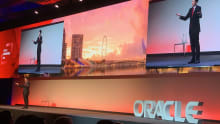Keeping the human in HCM

Let’s Talk Talent Read similar articles

While the hype around the introduction of Artificial Intelligence at the workplace will not die down, the fact remains that humans will still be the primary source of customer satisfaction, strategic capability, and innovation within organizations. So as organizations undertake their digital transformation journeys, simultaneously they also need to work on engaging and celebrating the unique and critical human capabilities they have at their disposal.
In an exclusive interaction with People Matters, John Hansen, Vice President, HCM Cloud Development, JAPAC, Oracle, who was a speaker at the Oracle OpenWorld Asia in Singapore, sheds light on how organizations can prepare for their digital transformation journey and yet make work more human.
What are the key factors organizations need to keep in mind when deciding on a digital transformation agenda?
It is an undisputed fact that as the world becomes more of a digital environment, organizations must, in turn, transform to become truly digital themselves. Those organizations that fail to embark upon, successfully complete and then harness this digital transformation will simply fail to exist. Technology is already, and will increasingly become, the dominant feature of each organization’s operations, so the need to establish a digital platform on which to base an organization’s digital operations is a non-negotiable aspect of strategy today.
Put simply, there are three key factors organizations should consider when developing and executing their digital transformation agenda:
The customers – As customers become more digitally-savvy, and increasingly use digital channels to interact with suppliers of goods and services, they will be drawn toward organizations that display the same or better level of digital capability. Organizations that do not provide digital channels with which to engage their customers, promote goods and services, enable effective commerce and provide a superlative customer experience, will vanish.
The organization – A digital platform provides a launchpad for three of the most important traits of modern, sustainable and successful organizations; namely, continuous improvement, rapid and ongoing innovation, and business agility to respond to an ever-changing marketplace. A successful digital transformation makes utilization and exploitation of technology a corporate differentiator, and also provides a platform for ongoing consumption of emerging and disruptive technologies.
The workforce – A digital transformation strategy will impact every aspect of the Human Capital Management arena. Through the adoption of cloud-based HCM applications, organizations will be enabled to promote collaboration, operational efficiencies and rapid innovation, while ensuring the workforce has the capabilities and insights needed to support the success of their organization
How has the role of HCM evolved over the past few years?
Human Capital Management practitioners within an organization today are more strategic, more effective and bigger contributors to their organization than ever before. Today, the focus for HCM professionals is on more effective support of line managers and people leaders in the organization. This is in the promotion/support of business agility and innovation, as agents for change, and most importantly in unleashing the capabilities of human talent within the organization.
Modern Cloud HCM applications are enabling HCM practitioners to evaluate the impact of emerging and disruptive technologies on workforce output and to take informed and insightful action to adopt and optimize all the varied inputs at an organization’s disposal.
What are some of the factors that will dictate successful change management while moving HCM to the cloud?
In order to successfully move an organization’s HCM operations to the cloud, a number of factors will need to be overcome. Of these, three are particularly impactful on the level of success achieved.
By definition, moving your HCM function to the cloud should address one of your largest inhibitors to organizational agility today; your legacy HR application. However, moving to a new HCM platform must be accompanied by a concerted effort to drive complexity from your operations. One approach to this issue is to adopt the leading-practice business flows directly available inside Oracle HCM Cloud. Another approach is to eliminate the use of customizations within your applications and business processes, and instead use the standard processes in tandem with personalization, which provides an upgrade-safe method of providing company-specific configuration and/or user experience while still utilizing the standard product
Resistance to change is a challenge faced by every project and initiative inside your organization.
“One way to win over those resistant to the new digital platform is to ensure they are able to work smarter, faster and with a more intuitive and enjoyable technology platform at their disposal.”
Highlighting the ‘quick wins’ and benefits of the new platform will improve the likelihood of acceptance and adoption of the new applications.
Leadership must be displayed at each stage of the transformation journey. Leadership must be utilized to clearly articulate the reason for the digital transformation, the benefits that will be gained for customers, employees and the organization as a whole, and the strategic imperative of embarking on the transformation journey, including the risks associated with not moving forward as quickly as possible.
How can organizations ensure that they do not lose the human touch while shifting to HCM solution?
For the last two years I’ve been advising customers to analyze how work gets done in their organization, and specifically, to gain an understanding of work output at a task, rather than job, level. This approach is necessary because automation, in all its guises (mechanical, production line, process, robotic and now AI-based) all address the replacement or augmentation of tasks, rather than the replacement of jobs, so any assessment of the impact of these new technologies needs to be carried out at the task-level.
Then, we gain more insight into which tasks within each job are candidates for automation, and which rely on uniquely human attributes, such as creative thinking, intuition, and judgement, innovation, discretion, personal interaction, collaboration and empathy. Once we gain an understanding of how these uniquely human attributes contribute to our endeavors, we can ensure that we do not lose the impact of the human touch inside our organizations.
(This article is based on an interaction with John Hansen, Vice President, HCM Cloud Development, JAPAC, Oracle in the background of Oracle OpenWorld Asia in Singapore. The next Oracle OpenWorld will be held at San Francisco from September 16-19, 2019.)







